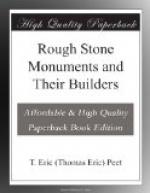[Illustration: FIG. 7. Type-plan of wedge-shaped
tomb. The roof slabs
are
two or more in number.]
In Munster the corridor-tomb takes a peculiar form (Fig. 7). It lies roughly east and west, and its two long sides are placed at a slight angle to one another in such a way that the west end is broader than the east. In a good example of this at Keamcorravooly, County Cork, there are two large capstones and the walls consist of double rows of slabs, the outer being still beneath the cover-slabs. On the upper surface of the covers are several small cup-shaped hollows, some of which at least have been produced artificially.
These wedge-shaped structures are of remarkable interest, for exactly the same broadening of the west end is found in Scandinavia, in the Huenenbetter of Holland, in the corridor-tombs of Portugal, and in the dolmens of the Deccan in India.
In some Irish tombs the corridor leads to a well-defined chamber. In a curious tomb at Carrickard, Sligo, the chamber was rectangular and lay across the end of the corridor in such a way as to form a T. The whole seems to have been covered with an oval mound. In another at Highwood in the same county a long corridor joins two small circular chambers, the total length being 44 feet. The corridor was once divided into four sections by cross-slabs. The cairn which covered this tomb was triangular in form.
In the county of Meath, in the parish of Lough Crew, is a remarkable series of stone cairns extending for three miles along the Slieve-na-Callighe Hills. These cairns conceal chamber-tombs. The cairns themselves are roughly circular, and the largest have a circle of upright blocks round the base. The chambers are built of upright slabs and are roofed by corbelling. Cairn H covered a corridor leading to a chamber and opening off on each side into a side-chamber, the whole group thus being cruciform. In these chambers were found human remains and objects of flint, bone, earthenware, amber, glass, bronze, and iron. Cairn L had a central corridor from which opened off seven chambers in a very irregular fashion. Cairn T consisted of a corridor leading to a fine octagonal chamber with small chambers off it on three sides.




